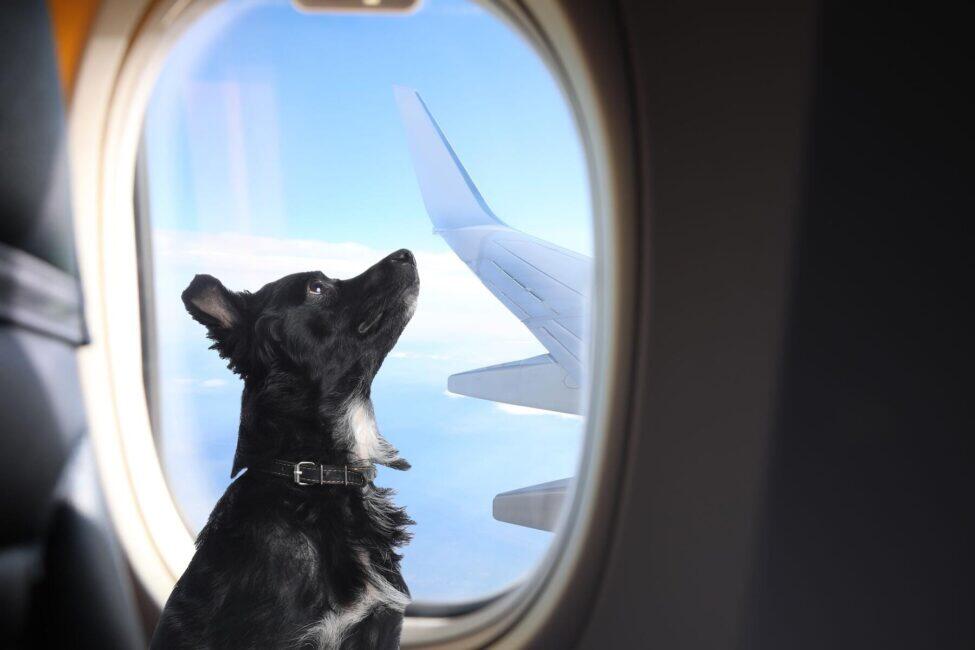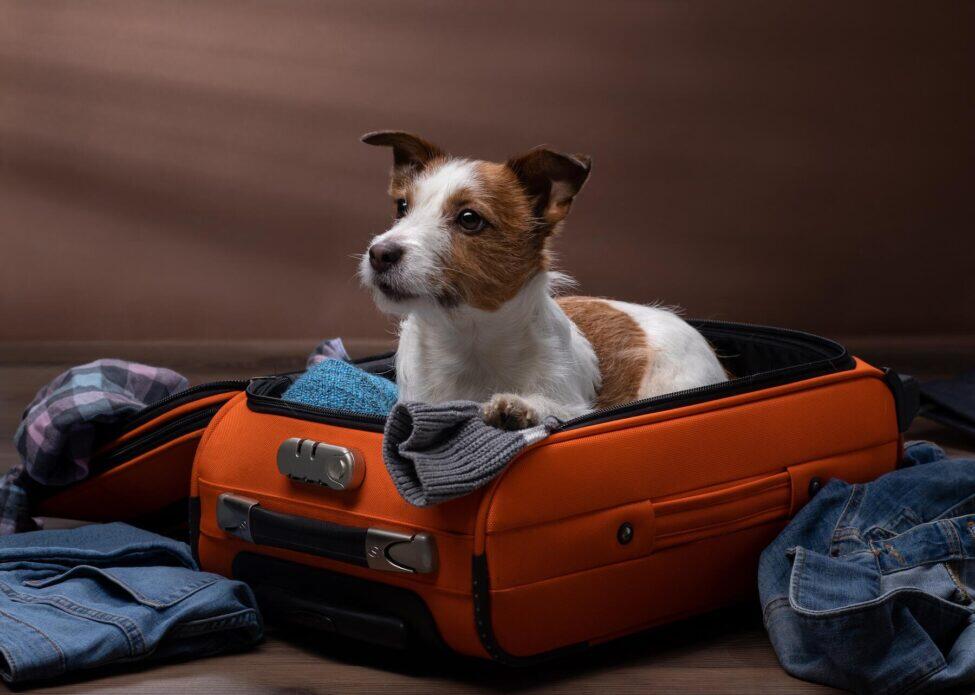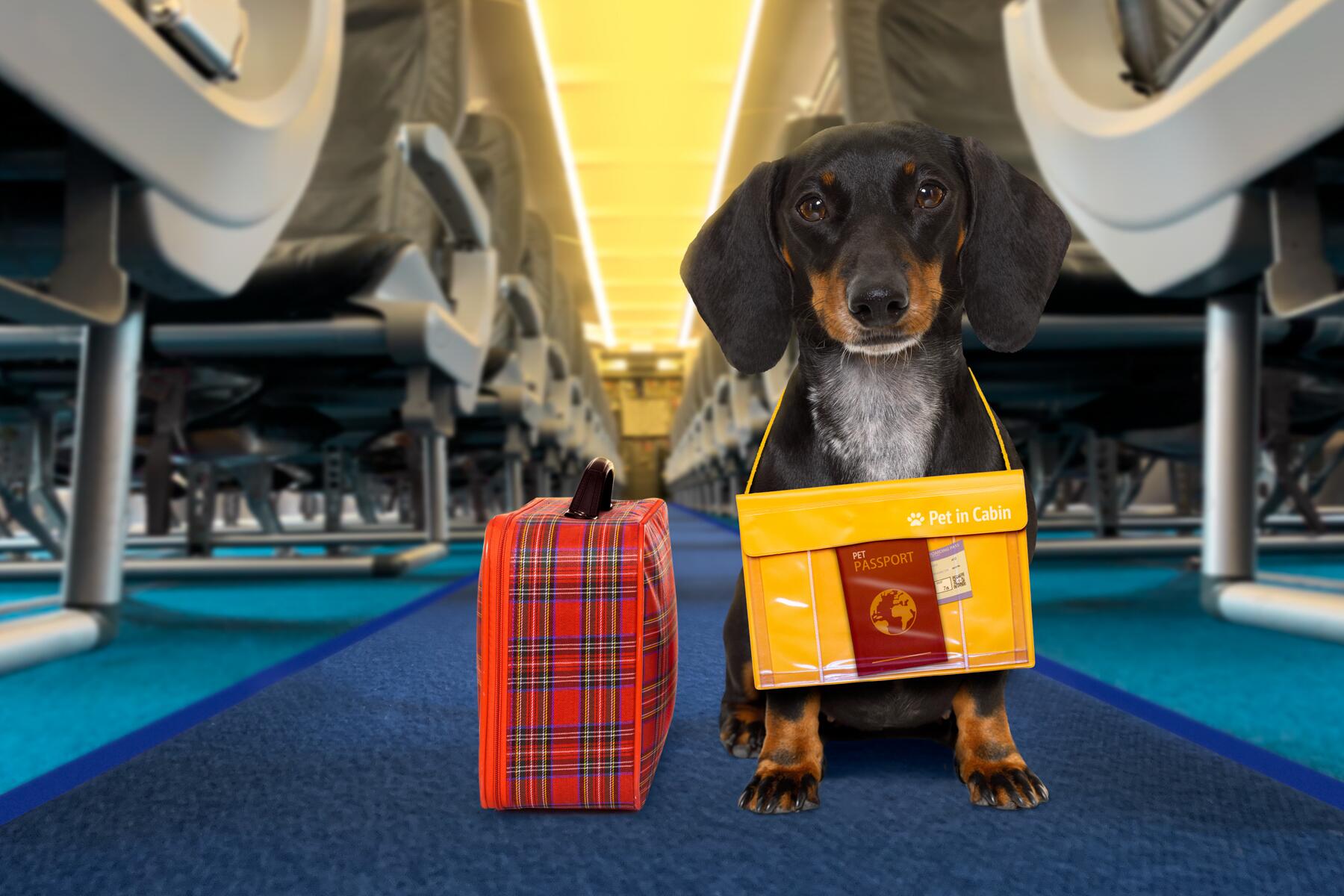A “pet passport” gives dogs admission to an elite class of international furry travelers.
That’s right, my dog has a passport. People usually widen their eyes in surprise and intrigue as those words slip out of my mouth. Their reaction makes sense since not even half of the American population currently have passports themselves (despite increased stats over the years).
With the convenience of a Pet Passport, my ultra-bossy rescue Yorkie, Roger Wellington, has already traveled to over 20 countries, which is quite impressive considering only 11% of Americans have been to 10 or more countries.
As dog ownership skyrockets, dog travel has, too. As of 2021, a whopping 48 million American households have a dog, and about 37% of pet owners travel with their dogs—a substantial 19% increase over the last decade. Besides the typical road trips, more and more dogs are flying on planes like never before. The Department of Transportation estimates that over two million pets travel by air each year. If you plan on traveling internationally with your dog often, the best investment you can make is to get a Pet Passport for your furry traveler.

What’s a Pet Passport?
Historically, the Pet Passport was “invented” and popularized by the European Union to make the movement of dogs easier within the E.U. and between the E.U. and the U.K. However, a “pet passport” can also mean all the paperwork required to import your dog into the destination country—with or without an official booklet. For example, the Veterinary Health Certificate and Rabies Certificate that are often required to get your dog in most countries can also be considered a “passport.” Hence, the term “pet passport” is essentially a collection of documents relating to your dog’s microchip, vaccination, and treatment history, titer test results, and overall health. These documents, or “passport,” are generally created by a veterinarian to help meet a country’s requirements for dog import.
Recommended Fodor’s Video
With that said, the term “pet passport” still largely refers to the E.U. Pet Passport, which is a document issued by an authorized veterinarian in a European Union Member State (a country in the E.U.) that contains official health information related to a specific pet. And yes, it’s a small blue booklet resembling a human passport; you can even insert a passport-sized photo of your dog to make it look more official, although that’s entirely optional. The “passport” will have pages to input the following information:
- Your dog’s name
- Your dog’s microchip number, breed, sex, date of birth, and color
- Your name and contact information
- Info of the veterinarian who issued the passport
- Your dog’s rabies vaccination history
- Your dog’s rabies antibody titer test results
- Your dog’s anti-echinococcus treatment
- Your dog’s other anti-parasite treatment and other vaccinations
- Your dog’s clinical examination history (showing no signs of diseases and is fit to be transported for the intended journey)
The E.U. Pet Passport is considered the golden ticket when it comes to traveling around Europe with your dog because your dog can freely cross E.U. borders without quarantine. Flash the passport at border control, and more often than not, your dog will be allowed to cross without much scrutiny. This makes traveling with your dog throughout the 27 E.U. member countries effortless.
In regards to Brexit, the only new requirement for U.K. citizens to travel to the E.U. with their dogs for the first time is an Animal Health Certificate rather than a Pet Passport issued in Great Britain (as of January 2021). Pet Passports issued in an E.U. country or Northern Ireland are still accepted, which makes it very convenient for U.K. dogs to enter.
For dogs traveling to the U.K. (England, Northern Ireland, Scotland, and Wales) with an E.U. Pet Passport, they will need to be treated for tapeworm (Echinococcus multilocularis) at least one to five days before entry. The treatment can be given and recorded in the dog’s E.U. Pet Passport by a USDA Accredited Veterinarian.
Dogs can also travel to neighboring countries that aren’t technically part of the E.U. like Andorra, Liechtenstein, Monaco, Norway, San Marino, and Switzerland. Thanks to the Pet Passport, Roger W. has left his mark in Europe’s greatest cities, including Amsterdam, Rome, Stockholm, Barcelona, Budapest, Prague, Vienna, Dubrovnik, Athens, and of course, the most famous dog-friendly European city: Paris.
Some non-European countries like Argentina will even honor the E.U. Pet Passport, so it comes in handy when you’re trying to do some major world traveling with your dog. But, most countries outside of Europe (like the U.S. and Japan) don’t have an official “pet passport” booklet; rather, they just have required documents for dog entry. As long as your dog has all the documents to enter the destination country, he technically has his “passport” to travel.
Getting your hands on an E.U. Pet Passport is a no-brainer for dog parents who love to travel. The E.U. Pet Passport is also a one-and-done process so you don’t need to repeat the steps once you have one (unless you don’t keep up with the rabies vaccinations). Obtaining an E.U. Pet Passport for your dog is easier than you think. Here’s a step-by-step guide on how can get an E.U. Pet Passport.

1. You’ll Need to Microchip Your Pooch
First things first, you must microchip your dog. Microchip implantation can be done at any accredited veterinarian in the U.S. for a nominal charge, ranging from $25 to $80. A microchip is a unique, permanent ID that ties your name and contact information to your dog. Despite being the size of a grain of rice, the microchip is scannable once it has been implanted underneath your dog’s skin. Even if you don’t plan on traveling internationally with your dog, microchipping your dog is always recommended in the unfortunate event that your dog ever becomes lost.
Europe uses the ISO-complaint 15-digit microchip, which is the standard for international dog travel. If you’re unable to attain a 15-digit microchip for your dog, then you must travel with your own microchip scanner. Of course, this isn’t ideal, but veterinarians in certain countries may only have a nine or ten-digit microchip available. Nonetheless, it sounds like a real hassle to deal with your own scanner so get the right microchip from the get-go if you can.
2. It Goes Without Saying, Your Pup Needs a Rabies Vaccination
After microchipping your dog, the next step is to vaccinate your dog against rabies. The rabies vaccine must be administered after the microchip implantation, not before. Otherwise, your dog will need to be re-vaccinated. Luckily, both the microchip and vaccination can occur on the same day, saving time and another costly vet visit (although it may be a painful day for your dog). The minimum time that the vaccination must be administered is at least 21 days before your dog arrives in the E.U. Even though the minimum age for dog entry is 12 weeks, I do not recommend traveling internationally with your dog until he or she is at least one year old due to the fact that dogs who travel best are the ones who are fully potty-trained and calmer.
If your dog has previously been microchipped and vaccinated against rabies, then you just need to make an appointment with the veterinarian. If your veterinarian doesn’t have your dog’s vaccination record, be sure to bring the rabies certificate to the appointment.
3. Getting Your Dog’s Health (and Health Certificate) in Order
Oftentimes, an accredited veterinarian can issue the Veterinary Health Certificate in the office—be sure to ask. If not, then you’ll need to print the certificate and bring it to the veterinarian for completion. Before visiting the veterinarian, make sure you print out the correct health certificate based on your country of origin. Also, make sure the certificate is for the non-commercial transport of animals.
If you can, get the microchip, rabies vaccination, and veterinarian health certificate done in a single appointment. It ultimately depends on your veterinarian since all veterinarians may operate differently. Some will charge more than others or require additional visits, which was in my case.
The costs started to pile on because I had to make an appointment with a specific vet specializing in travel after the microchip and rabies appointment. After meeting with the special “travel” vet, I had to make another appointment to pick up the completed and signed certificate because he would not give it to me on the same day. What a pain!
Besides acquiring the required paperwork for international dog travel, your dog should get a thorough examination from the veterinarian to ensure that he is healthy enough to fly overseas. If your dog has any pending health issues, be sure to address them with the veterinarian before booking the flight. Since air travel can be stressful for dogs, it’s best to get approval from the veterinarian for your dog to travel internationally.
Keep in mind that the date format differs in Europe (DD-MM-YYYY) so any mix-up dates can make the paperwork or vaccination appear expired and risk entry for your dog. Once signed by an accredited veterinarian, the health certificate is valid for 30 days.
4. Getting the Health Certificate Endorsed
The next step is to get the Veterinary Health Certificate endorsed by your local APHIS Veterinary Services Office (U.S.), which costs $38. Once endorsed, your dog must arrive in the E.U. within 10 days. Otherwise, the paperwork is void. For Canadian travelers, the Canadian Food Inspection Agency (Canada) charges 20 CAD for endorsement.
Since I was in Los Angeles at the time, I drove to the Los Angeles Animal Import Center (LA AIC) right after the veterinarian visit. The office is located in El Segundo near LAX (Los Angeles International Airport) and is one of the two APHIS Veterinary Services Offices in California (with the other one in Sacramento in NorCal). Surely, I prepared myself for a brutal DMV-type encounter only to be pleasantly surprised when my total wait time was only around 20 minutes on a random Tuesday. I brought Roger W.’s rabies certificate, a copy of my flight reservation, and of course, the E.U. Health Certificate requiring endorsement. The clerk briefly scanned my paperwork, stamped the certificate, and handed it back to me. That was it! It was much smoother than expected. To save time, check with your local APHIS Veterinary Services Office to see if an appointment is needed.
Once stamped, the E.U. Health Certificate is valid for travel within the E.U. for up to 4 months (or until the rabies vaccination expires, whichever comes first). I’ve found that the paperwork is rarely examined upon arrival in the E.U., but it’s better to have it ready and be on the safe side when traveling with your dog.
5. Paperwork = An E.U. Pet Passport
When you and your dog arrive in the E.U., take your dog to a veterinarian with all the paperwork to exchange for an E.U. Pet Passport. Remember to call around to make sure the veterinarian is authorized to issue the passport for your dog before making an appointment. Depending on the E.U. country you’re in, you can get affordably for 10 or 20 euros.
Please note that you can only obtain an E.U. Pet Passport for your dog from an authorized vet once you’re in the E.U., which means your dog must arrive in the E.U. to get one. If you have time, this visit to the vet on your trip is well worth the investment and money. After all, the E.U. Pet Passport is valid for as long as the rabies vaccination is up to date. And, you do not have to be an E.U. citizen to get a passport for your dog.
The best part is that the exchange is pretty much a one-and-done process. Nearly six years ago, I went to a veterinarian in Budapest, Hungary, to exchange the E.U. Health Certificate for an E.U. Pet Passport for less than $20. That’s right! The entire visit took about 15-20 minutes. With an E.U. Pet Passport, I won’t have to deal with the Veterinary Health Certificate or USDA endorsement again and I can return to Europe with Roger W. whenever I want. If you choose not to exchange the paperwork for an E.U. Pet Passport, then you’ll have to get your paperwork updated after the four-month expiration.
Just a warning that a U.S. veterinarian should not enter information in any section designated “Authorized Veterinarian,” as this could lead to invalidation of the passport and your dog could be denied entry! Only E.U. veterinarians can update the rabies vaccination record, which means that any rabies booster shots must be administered by an E.U. veterinarian.
A Complete Cost Breakdown For Getting A Pet Passport
ISO-Compliant Microchip: The 15-digit ISO microchip is the international standard for dog travel and costs anywhere from $25 to $80, depending on your veterinarian’s office and region.
Completion of E.U. Health Certificate: Anywhere from $150 to $400 depending on your veterinarian. Again, the number of visits required to complete the certificate may vary. The completion of the form usually requires a separate office visit for a health check-up. In Los Angeles, I spent over $300 for the form completion: two vet visits (each about $100) plus a standard health check-up ($100). There was also a separate charge for the form completion. The costs can be significantly lower depending on your veterinarian or region. Of course, this does not include the costs to address any pending or new health issues, which may require additional visits or treatment.
Rabies Vaccination: Chances are your dog is already vaccinated against rabies so you may or may not incur this expense. If your dog was vaccinated before being microchipped (which was the case of Roger W.), then another rabies vaccine must be administered after microchip implantation. The cost of a rabies vaccine ranges anywhere from free to $50.
Flight reservation: $125 to $200 for a one-way flight to Europe for your dog, depending on the airline. This fee does not include your own flight reservation. Because only E.U. veterinarians can issue an E.U. Pet Passport, your dog must be in the E.U. to obtain one.
USDA APHIS Endorsement of the E.U. Health Certificate: $38. If you’re in Canada, it’s 20 CAD for endorsement from the Canadian Food Inspection Agency.
Official E.U. Pet Passport: $20 to $100 (depending on which E.U. country you get this done in AND whether or not they charge an office visit in addition to the passport). As mentioned earlier, I was in Budapest at the time and got a passport for Roger W. for a measly $20. Expect to pay more if you’re in Western Europe.
Total Estimate Costs: $358 to $868 (not including transportation to complete the paperwork). This range is so wide because veterinary costs differ from region to region, depending on reputation and quality of care.

Is a Pet Passport Worth It?
Despite the costs and time in obtaining a Pet Passport for Roger W., I can attest that it is well worth it in the end. Thanks to the E.U. Pet Passport, Roger W. and I have bummed around the Greek Islands, grabbed mouthwatering Belgian waffles and frites in Brussels, admired Gaudi’s La Sagrada Familia in Barcelona, explored the magnificent grounds of the Louvre Palace in Paris, and celebrated July 4th with a Romanian family and their Shih-Tzu at Old Town in Bucharest, among many other marvelous experiences. Traveling with your dog provides a much more enriching experience because it not only deepens the bond between you and your dog, but also allows you to connect with dog people along the way.





